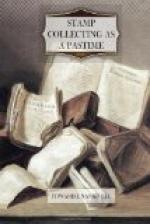[Illustration:]
XI.
The Literature of Stamps.
Few hobbies, if any, can boast of such a varied and extensive literature as stamp collecting. Expensive works have been published on the postal issues of most countries. They have been published in English, French, German, Italian, Spanish, Dutch, Danish, and Swedish. Those published in English alone would make a library of some hundreds of volumes.
From its foundation, in 1869, the Philatelic Society of London has set itself the task of studying and writing up the postal history of Great Britain and her Colonies. Towards the accomplishment of this great task, it has already presented its members with splendid monographs on the Australian Colonies, the Colonies of North America, of the West Indies, of India and Ceylon, two volumes on the British Colonies of Africa, a separate monograph on Tasmania, and last, and most ambitious of all, a massive and comprehensive history of the postal issues of Great Britain. All these works are expensively illustrated with a profusion of full-page plates and other illustrations, and they represent years of patient toil, far-reaching investigation, and untiring research. The History of the Adhesive Postage Stamps of Europe has been written in two volumes by Mr. W. A. S. Westoby, and the same author, in collaboration with Judge Philbrick, some twenty years ago published a work on The Postal and Telegraph Stamps of Great Britain. Messrs. W. J. Hardy and E. D. Bacon, in a work entitled The Stamp Collector, have sketched the general history of postage stamps. Other works too numerous to mention here have been written from time to time for the edification of the stamp collector, and the list is continually being increased by the addition of even more important works.
One of the most interesting and comprehensive series of philatelic works, still in course of publication, was commenced by Messrs. Stanley Gibbons, Ltd., in 1893, in the form of philatelic handbooks. These handbooks are written by leading philatelic authorities. Each important country, i.e. important from the stamp collector’s point of view, has a separate volume devoted to it, and into each handy volume is condensed as much as may be necessary to guide the advanced collector in specialising the postal issues of the country which he favours. There have already been published:—Portuguese India, by Mr. Gilbert Harrison and Lieut. F. H. Napier, R.N.; South Australia, by Lieut. F. H. Napier and Mr. Gordon Smith; St. Vincent, by Lieut. F. H. Napier and Mr. E. D. Bacon; Shanghai, by Mr. W. B. Thornhill; Barbados, by Mr. E. D. Bacon and Lieut. F. H. Napier; Reprints and their Characteristics, by Mr. E.D. Bacon; and Grenada, by Mr. E. D. Bacon and Lieut. F. H. Napier.
For the instruction of the beginner, Major Evans, R.A., has compiled an excellent glossary of philatelic terms, under the title of Stamps and Stamp Collecting; and there is, further, A Colour Dictionary, by Mr. B. W. Warhurst, designed to simplify the recognition and determination of the colours and shades of stamps—a by no means unimportant matter when the value of a stamp depends upon its shade.




